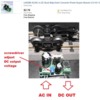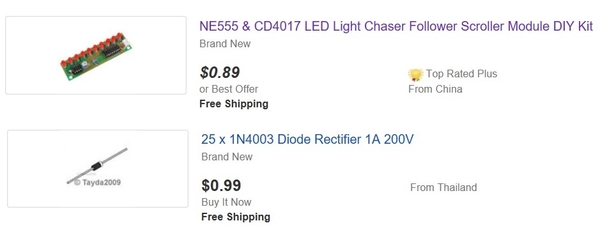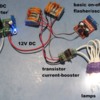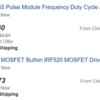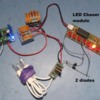I am building a new BOF (Steel producing facility) on my layout. It will have two large and tall BOF stacks each with three red lites at the top. I want to make all 6 flash at the same time. Is there some type of unit or logic board that I can use for this? I am thinking they would pull about 1 amp at about 14 volts give or take??? Thanks, Nick
Replies sorted oldest to newest
1. What is the part number of the 6 red lights? Are these incandescent bulbs (not LEDs)?
2. Where did you come up with 1 Amp at 14V? (Seems a bit high).
3. Do you want this powered by 14V AC Accessory Voltage?
stan2004 posted:1. What is the part number of the 6 red lights? Are these incandescent bulbs (not LEDs)?
2. Where did you come up with 1 Amp at 14V? (Seems a bit high).
3. Do you want this powered by 14V AC Accessory Voltage?
Stan I don't have a part number for the lites. They are just red incandescent wheat grain bulbs. The 1 amp was just a guesstimate with some extra lee way. I use a PW ZW for lighting.
Here's an option: LED Tail Light Conversion Flasher for $7.57 on eBay.
Runs off 11-15VDC and will handle incandescent or LED bulbs. You will need a bridge rectifier if you want to power it with the ZW. The unknown is the voltage requirement of your grain of wheat bulbs. If they are 3 volt bulbs, wire all 6 bulbs in series and in series with the flasher unit. You will need to meter the DC output voltage and advance the ZW handle until you get 15v. This will slightly under power the bulbs, but they will last longer. A better option is to connect the bridge rectifier output to one of the DC buck converters with a digital display so you can easily dial in the correct voltage. These only cost a few dollars on eBay. You'll find discussion of these in several of Stan's posts.
If you want to change the bulbs to LEDs, a really simple option is to wire 5 red LEDs in series with 1 red flashing LED and a 100 ohm resistor and run it off 14v DC from the ZW/bridge rectifier/buck converter. The circuit will only use 20mA.
Bob Glorioso
Attachments
As RRDOC suggests, I too would take a good look at some automotive flasher widgets. I was looking on eBay and was amazed to find flasher modules for 99 cents (free shipping from Asia). ![]()
The one shown above even has a screwdriver adjust to set the flash rate. ![]()
Anyway, it appears these gadgets operate on DC because they actually have electronics inside that run on DC...rather than the old-school thermal strip flashers that open and close from heating. To generate DC from your 14V AC, I don't think you can do this with just a bridge rectifier. That is, I believe these modern flasher modules require a somewhat smooth DC which a bare-bones bridge does not provide. That said, I did hook up an eBay $3 AC-to-DC converter module to the 14V AC Accessory output from a train transformer. I was able to generate 1 Amp of 12V DC.
There are some details to work out if you need a full 14V DC starting from "only" 14V AC at 1 Amp of current. But as a start I'd consider driving the lamps at 12V DC and if bright enough have the additional benefit of a vastly longer life. I figure it's probably a nuisance to replace a bulb in your smoke stacks!
I don't know about the module RRDOC suggests, but the one above actually has an electro-mechanical relay inside so it would be clicking as it turns on/off. I don't know how these flashers are specified for durability but at, say, 1 flash per second the relay is cycling 3600 times per hour, or almost 100,000 times per day! OK, so you only run your Steel Mill a few hours a day or whatever. And I suppose if the relay module fails after a year it will set you back 99 cents!
I did try to sketch out a solid-state timer solution (no moving parts) using low-cost eBay modules but couldn't come up with anything close to the simplicity of an automotive flasher.
Another approach might be to find an O-gauge crossing-gate flasher board that drives incandescent lamps from the pre-LED era. It would take some study to see if it could handle 1 Amp. I'm pretty sure I've seen circuit or modules for this application that used transistors to switch the lamps on/off so it would be a quiet, no-moving-parts solution which should be more robust than a clicking relay.
Attachments
One problem with automotive flashers is the click-click that you'll have as the lights operate. I'm guessing that would annoy the crap out of me!
BOF mills are incredibly noisy ... I doubt you'll be able to hear a clicking relay. ![]()
![]()
ROCKSTARS, you may want a more realistic blink rather than, off on off on, like the typical turn signal in a car. Most aircraft warning lights have a blink that builds in brightness then dims down. The MTH bridges have that realistic blink to the as well as their end of train devices. There is a small circuit board in the bridge pier that you maybe able to duplicate to achieve that type of flash.
Attachments
To get the pulsating effect you have a couple of options, both using LEDs.
DIY option: Do a web search for Pulsating LED or Throbbing LED circuits. These use a 555 timer. There are easy to follow YouTube videos on how to construct the circuit. To drive 6 LEDs you can power it with 9 volts DC and run 2 strings of 3 LEDs with a dropping resistor. Or you can run all 6 LEDs in parallel each with its own resistor.
Ready made option. Ngineering makes all kinds of flashing circuits. They do require a some soldering to attach power leads and LED leads. To run 6 LEDs you will need N 8071 Tower Beacon/Strobe Simulator and N 8103 Booster board. They include detailed instructions including how to connect multiple LEDs and what dropping resistors to use. This is much more costly ($28) than the DIY option, but worth it if you are not comfortable building circuits and figuring out LED dropping resistors.
Bob Glorioso
STAN-DAVE-RR wow thanks for all of the info I have a lot to consider. GRJ-I never thought of the clicking..maybe I could make a 3/4 plywood insulated box to install it in haha.Here in Cleveland Ohio we have a huge integrated Steel Mill (ARCELORMITTAL) We have two BOF's. One has very high and large diameter stacks. The lights on top flash two times fast then pause then repeat. So I am looking to keep it simple and just make them flash on and off at a constant pace. I might try to take a video and post it here if I can get it to turn out ok in the dark. Thanks guys, I think this will be a fun project. I will mock it up on my bench and test before I install. Nick
I've been thinking about the "click-click" if using a relay. Additionally, a relay might have a rated life of "only" 1 Million cycles which actually isn't that long if running 24/7.
So seeing as this is the Electrical Forum, if willing to do some DIY handi-work here's another option that does NOT use a relay but can drive the relatively large lamp (not LED) currents.
On the left is the AC-to-DC converter discussed earlier. This converts 14V-16V AC Accessory voltage to a stable DC voltage (e.g., 12V DC). In the upper right is a $1 (free shipping from Asia) cycle-timer module that can be set to a, say, 1 second cycle time. These modules can only drive a modest current (certainly not 1 Amp). So a transistor buffer is used to boost the current to drive incandescent bulbs. It's a basic circuit requiring less than 50 cents in generic components; I hand-built one but I see such transistor (FET) modules are also available on eBay for $1 (free shipping from Asia).
And here's what it might look like:
The video also illustrates one approach to the double-flash scenario. Instead of a basic on-off-on-off-on-off cycle timer module, you can get a so-called Chaser module for...wait for it... $1 (free shipping from Asia). Unfortunately for the $1 version it comes as a kit so soldering is involved. But the idea is you get a module with 10 LEDs that flash in sequence: 1,2,3,4,5,6,7,8,9,10,1,2,3,4...etc. With the addition of two 5-cent diodes, you can use the transistor buffer to drive the lamps when the Chaser count is, say, 1 and 4. So the timing would be ON,OFF,OFF,ON,OFF,OFF,OFF,OFF,OFF,OFF, repeat.
Yes, this unusual double-flash timing is easily implemented in an Arduino or similar programmed-microcontroller. But writing software is not in everyone's comfort zone. And I'm sure if one looked hard enough there might even be an off-the-shelf module that performs this type of solid-state (no moving parts, no clicking sound) flashing of multiple incandescent bulbs. Though it's hard to imagine such a widget would be less expensive out-of-pocket than the proposed solutions herein.
Attachments
Brilliant, Stan! I love your "Rube Goldberg" solutions to these problems.
Bob
I do marvel at how Stan finds all this obscure stuff and then combines it into a workable solution, certainly an interesting talent! ![]()







